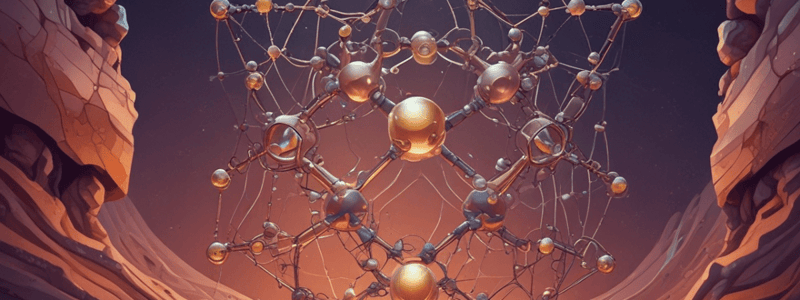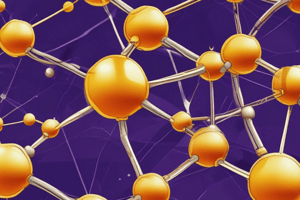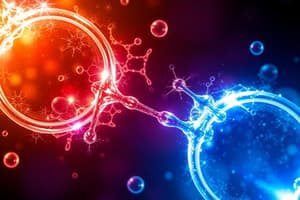Podcast
Questions and Answers
What is the main component of the 'sea' in metallic bonding?
What is the main component of the 'sea' in metallic bonding?
- Neutrons
- Valence electrons
- Positive ions
- Delocalized electrons (correct)
What is the purpose of the colored balls in the model-building activity?
What is the purpose of the colored balls in the model-building activity?
- To represent delocalized electrons
- To represent the electrostatic forces
- To represent positive metal ions (correct)
- To represent the crystal lattice
What is the arrangement of atoms in a Body-Centered Cubic (BCC) crystal lattice?
What is the arrangement of atoms in a Body-Centered Cubic (BCC) crystal lattice?
- Atoms are at the corners of a cube with atoms at the centers of each face of the cube
- Atoms are at the corners of a cube with one atom at the center of the cube (correct)
- Atoms are packed closely together in a hexagonal arrangement
- Atoms are arranged in a random pattern
What is the name of the crystal lattice structure where atoms are packed closely together in a hexagonal arrangement?
What is the name of the crystal lattice structure where atoms are packed closely together in a hexagonal arrangement?
What is the role of the sticks in the model-building activity?
What is the role of the sticks in the model-building activity?
What is the purpose of the model-building activity?
What is the purpose of the model-building activity?
What type of electrons are lost by metal atoms to form positive ions?
What type of electrons are lost by metal atoms to form positive ions?
What is the arrangement of atoms in a Face-Centered Cubic (FCC) crystal lattice?
What is the arrangement of atoms in a Face-Centered Cubic (FCC) crystal lattice?
What is the main characteristic of metallic bonds?
What is the main characteristic of metallic bonds?
What is the definition of a metallic bond?
What is the definition of a metallic bond?
What is the reason behind the high melting and boiling points of metals?
What is the reason behind the high melting and boiling points of metals?
Why are metals good conductors of electricity?
Why are metals good conductors of electricity?
What is the reason behind the shininess of metals?
What is the reason behind the shininess of metals?
Why are metals malleable and ductile?
Why are metals malleable and ductile?
What is a characteristic of metals due to the densely packed positive nuclei?
What is a characteristic of metals due to the densely packed positive nuclei?
What is the term for the delocalized electrons in a metal?
What is the term for the delocalized electrons in a metal?
What is the primary force that holds the metal ions together in a metallic bond?
What is the primary force that holds the metal ions together in a metallic bond?
What is the purpose of the model-building activity in understanding metallic bonding?
What is the purpose of the model-building activity in understanding metallic bonding?
What is a common feature of the different crystal lattice structures found in metals?
What is a common feature of the different crystal lattice structures found in metals?
What is a result of the delocalized electrons in a metal?
What is a result of the delocalized electrons in a metal?
What is a characteristic of the 'sea' of delocalized electrons in a metal?
What is a characteristic of the 'sea' of delocalized electrons in a metal?
What is the advantage of exploring different crystal lattice structures in metals?
What is the advantage of exploring different crystal lattice structures in metals?
What is the arrangement of metal ions in a metal?
What is the arrangement of metal ions in a metal?
What is a consequence of the electrostatic forces between the metal ions and delocalized electrons?
What is a consequence of the electrostatic forces between the metal ions and delocalized electrons?
What is the primary reason for the electrical conductivity of metals?
What is the primary reason for the electrical conductivity of metals?
What is the main characteristic of the metallic bond that gives metals their distinctive properties?
What is the main characteristic of the metallic bond that gives metals their distinctive properties?
What is the reason behind the high thermal conductivity of metals?
What is the reason behind the high thermal conductivity of metals?
What is the reason behind the malleability and ductility of metals?
What is the reason behind the malleability and ductility of metals?
What is the characteristic of metals that is responsible for their shininess?
What is the characteristic of metals that is responsible for their shininess?
What is the primary reason for the high density of metals?
What is the primary reason for the high density of metals?
What is the result of the strong electrostatic attraction between the positively charged nuclei and the negatively charged delocalized electrons in metals?
What is the result of the strong electrostatic attraction between the positively charged nuclei and the negatively charged delocalized electrons in metals?
What is the characteristic of metallic bonding that distinguishes it from covalent and ionic bonds?
What is the characteristic of metallic bonding that distinguishes it from covalent and ionic bonds?
What is the primary reason for the flexibility of metals?
What is the primary reason for the flexibility of metals?
Which of the following is a characteristic of the crystal lattice structure of metals?
Which of the following is a characteristic of the crystal lattice structure of metals?
What is the primary reason for the ability of metals to maintain their structure?
What is the primary reason for the ability of metals to maintain their structure?
What is the result of the delocalized electrons in a metal undergoing a physical change?
What is the result of the delocalized electrons in a metal undergoing a physical change?
What is the primary advantage of exploring different crystal lattice structures in metals?
What is the primary advantage of exploring different crystal lattice structures in metals?
What is the primary characteristic of the 'sea' of delocalized electrons in a metal?
What is the primary characteristic of the 'sea' of delocalized electrons in a metal?
What is the primary reason for the high melting and boiling points of metals?
What is the primary reason for the high melting and boiling points of metals?
What is the primary characteristic of metallic bonds that gives metals their distinctive properties?
What is the primary characteristic of metallic bonds that gives metals their distinctive properties?
What is the primary reason for the high melting and boiling points of metals?
What is the primary reason for the high melting and boiling points of metals?
What is the characteristic of metals that allows them to be drawn into wires?
What is the characteristic of metals that allows them to be drawn into wires?
What is the result of the delocalization of valence electrons in metals?
What is the result of the delocalization of valence electrons in metals?
What is the primary force that holds the metal ions together in a metallic bond?
What is the primary force that holds the metal ions together in a metallic bond?
What is the characteristic of metals that is responsible for their ability to conduct electricity?
What is the characteristic of metals that is responsible for their ability to conduct electricity?
What is the characteristic of metals that allows them to absorb and re-emit light?
What is the characteristic of metals that allows them to absorb and re-emit light?
What is the result of the densely packed positive nuclei in metals?
What is the result of the densely packed positive nuclei in metals?
What is the primary characteristic of metallic bonds that distinguishes them from covalent and ionic bonds?
What is the primary characteristic of metallic bonds that distinguishes them from covalent and ionic bonds?
What is the primary function of the delocalized electrons in a metal?
What is the primary function of the delocalized electrons in a metal?
What is the main advantage of exploring different crystal lattice structures in metals?
What is the main advantage of exploring different crystal lattice structures in metals?
What is the result of the electrostatic forces between the metal ions and delocalized electrons in a metal?
What is the result of the electrostatic forces between the metal ions and delocalized electrons in a metal?
What is the characteristic of metals that arises from the delocalized electrons?
What is the characteristic of metals that arises from the delocalized electrons?
What is the benefit of using a model-building activity to understand metallic bonding?
What is the benefit of using a model-building activity to understand metallic bonding?




